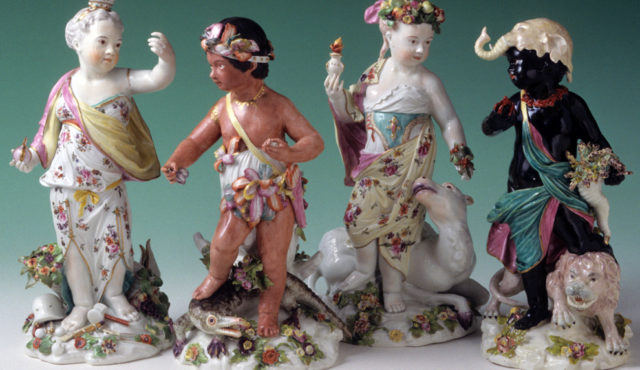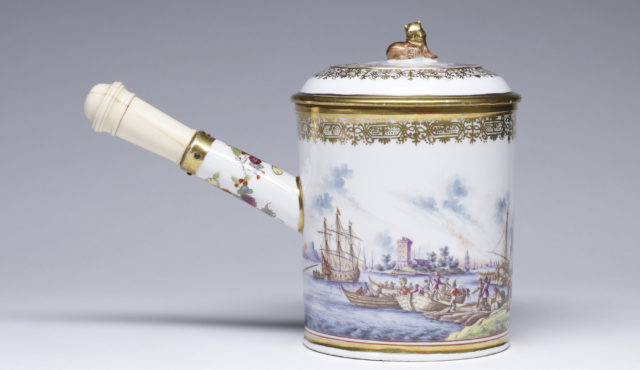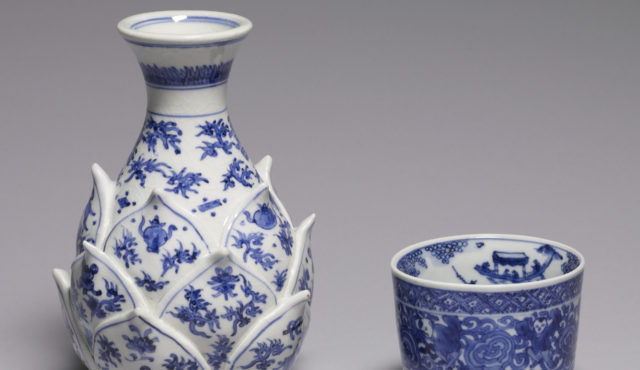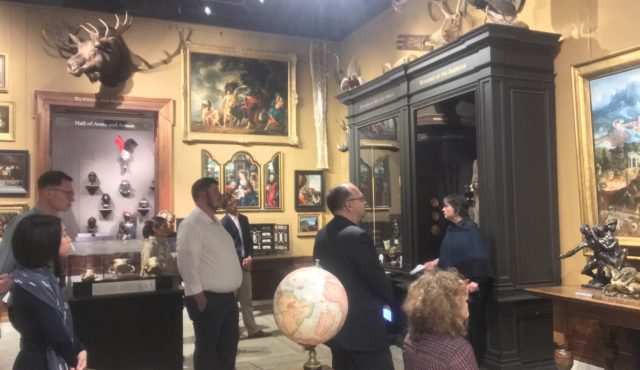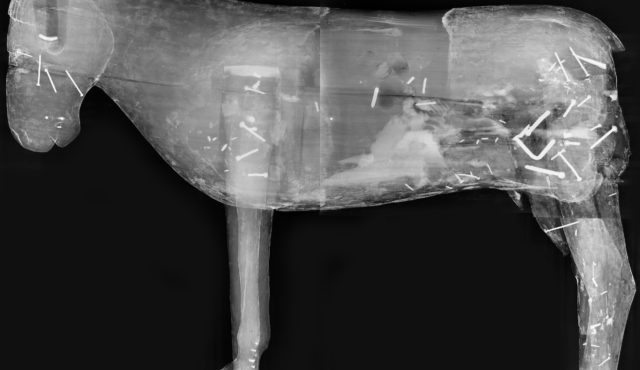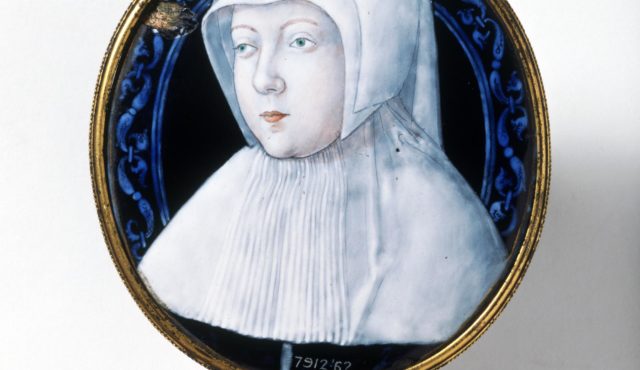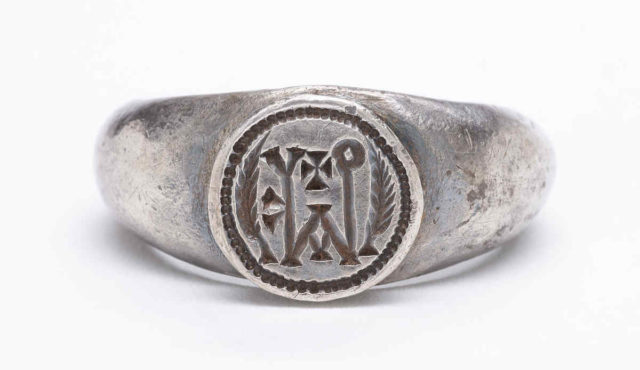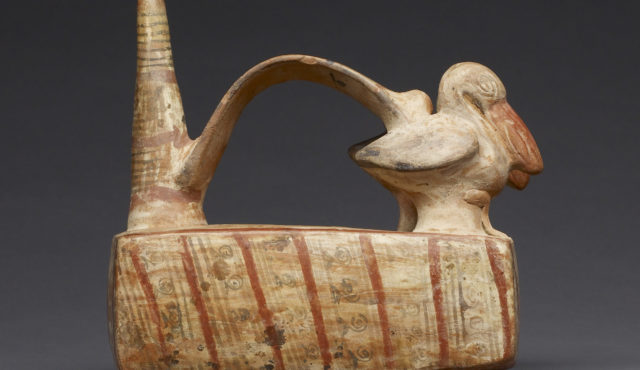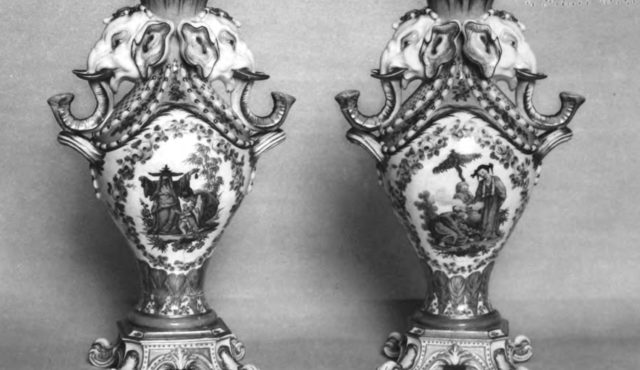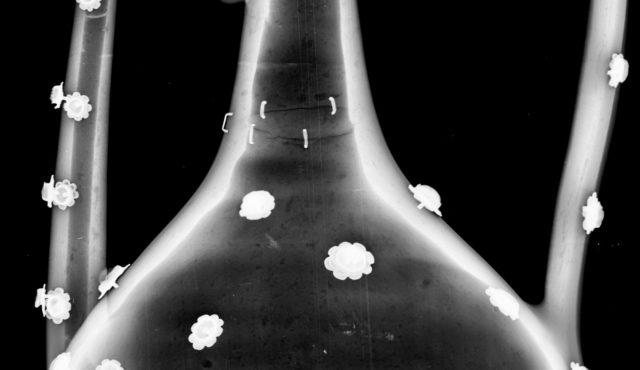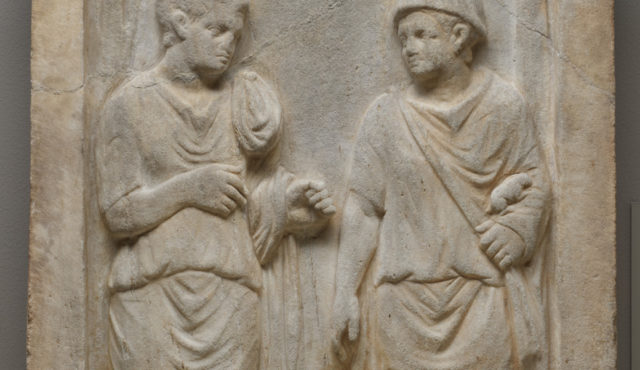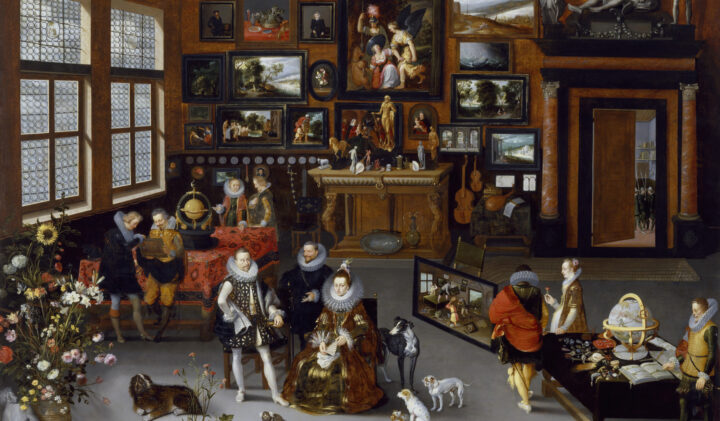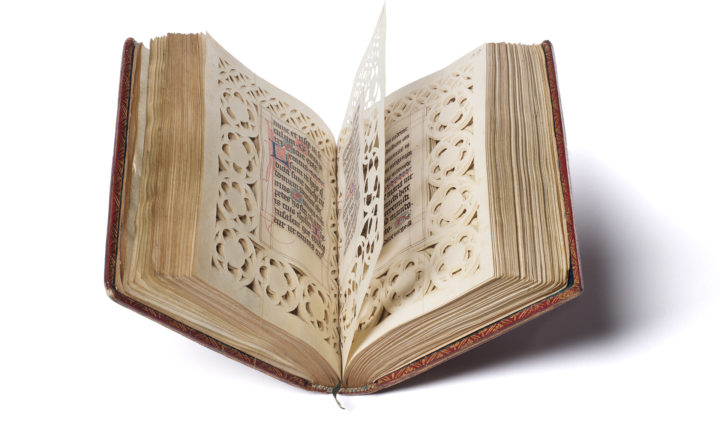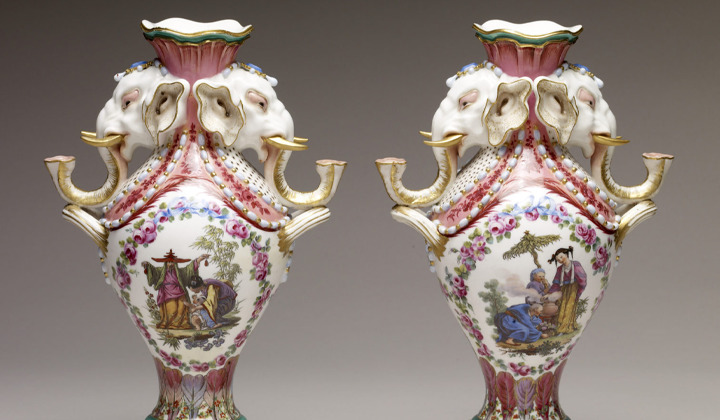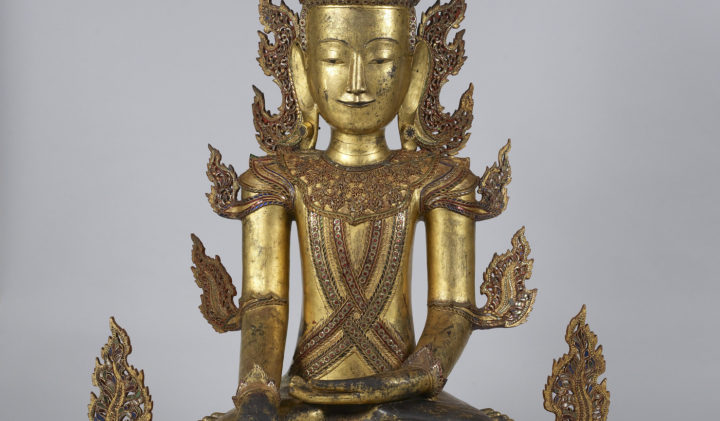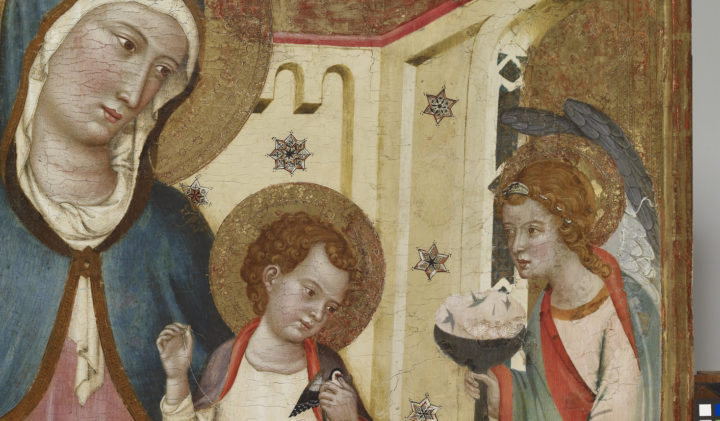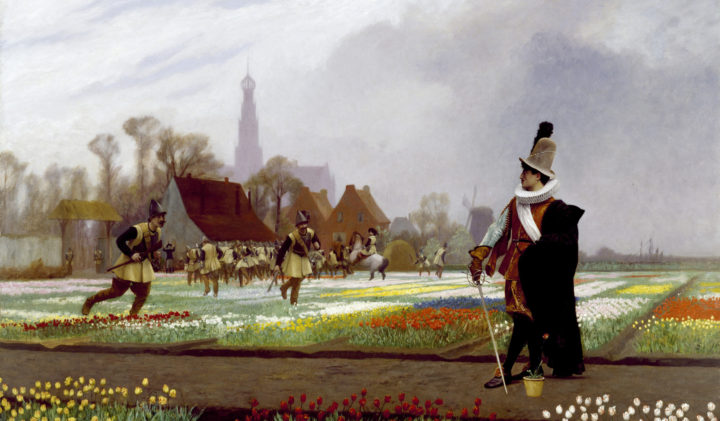In 1986 the Walters Art Museum purchased a silver Byzantine ring from the Günter Puhze gallery in Freiburg, Germany (fig. 1). The ring, dated to the sixth or seventh century CE, consists of a narrow convex band and a raised circular bezel with an incised design in reverse. This design features a monogram composed of Greek letters, a cross, and two palm fronds, surrounded by a dotted line. The reverse incised form of this design indicates that the ring functioned as a signet. The wearer would have pressed the bezel into a bed of soft wax leaving behind a mirror image, relief impression, or seal, that could be attached to letters, contracts, and personal property for authentication and protection.[1]

Signet Ring with “of Akakios” in Greek, Byzantine, 6th–7th century. The Walters Art Museum, Baltimore, Museum purchase, 1986, acc. no. 57.2104
The ring is exhibited at the Walters in the gallery of Early Byzantine art and is accessible on the Walters’ website.[2] The only substantial publication on the ring is found in the 2011 book, The Medieval World: The Walters Art Museum, by Martina Bagnoli and Kathryn Gerry.[3] This catalogue of nearly 150 objects serves as a guide to the medieval collections and an introduction to the material culture of the Middle Ages. The short entry on the ring erroneously states that the monogram is composed of Latin letters, which translate as “of Mark.” The Walters’ website corrects the first error, indicating that the monogram is composed of Greek letters, but maintains the reading “of Mark.” This research note demonstrates that the monogram identifies the wearer as “Akakios,” and then shows that the misattribution reflects the ways in which signet rings have been studied and presented in publications and museum exhibitions.
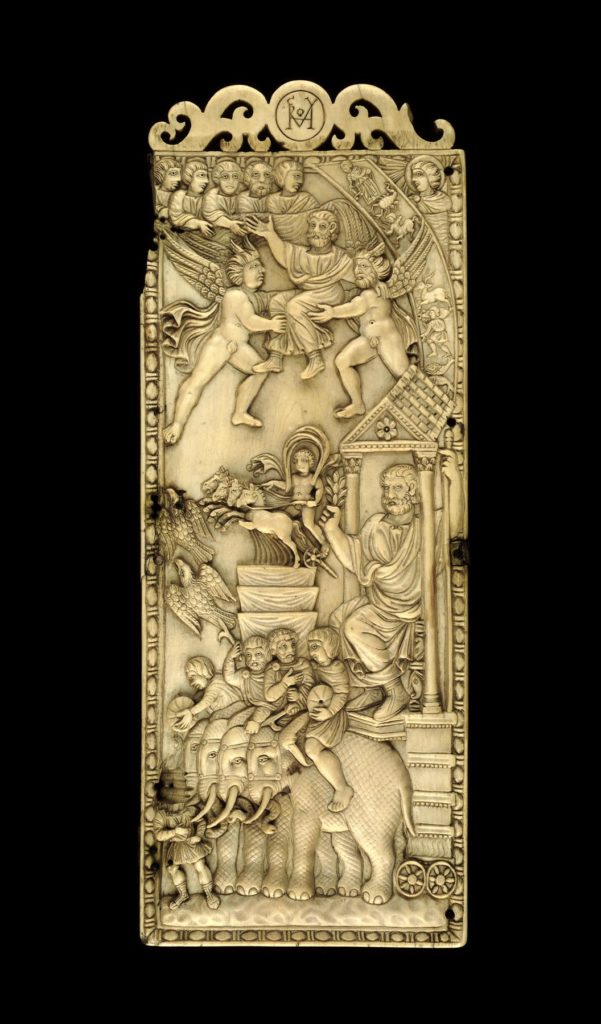
The Gherardesca Diptych, Late Roman, 402, elephant ivory. The British Museum, 1857,1013.1. © The Trustees of the British Museum
A monogram is part text, part image. The letters of a name, title, word, or phrase are isolated, rearranged, and combined into a single graphic device. Monograms became a notable feature of late Roman aristocratic culture in the fourth and fifth centuries CE, when prestigious families and high-ranking civic officials had their monograms inscribed on ivories, silver plates and spoons, and signet rings.[4] Many of these unique symbols were—and still are—difficult to decipher, which appealed to the members of the elite who used monograms as markers of their social status and presumed intellect. Quintus Aurelius Symmachus (ca. 345–ca. 402 CE), a Roman statesman in the late fourth century, wrote that his monogram was “more to be understood than to be read.”[5] His family’s monogram is found on the Gherardesca panel (ca. 402 CE), one half of an ivory diptych that depicts the funeral and apotheosis ceremony of Quintus Aurelius himself (fig. 2).[6] The monogram, inscribed at the center of the upper frame, combines the Latin letters of his family’s name in the genitive case (a function of grammar marking possession or association): SYMMACHORUM (“of the Symmachi”). Personal monograms typically render the name in the genitive, indicating that the symbol, and the object upon which it is inscribed, belong to the named family or individual.
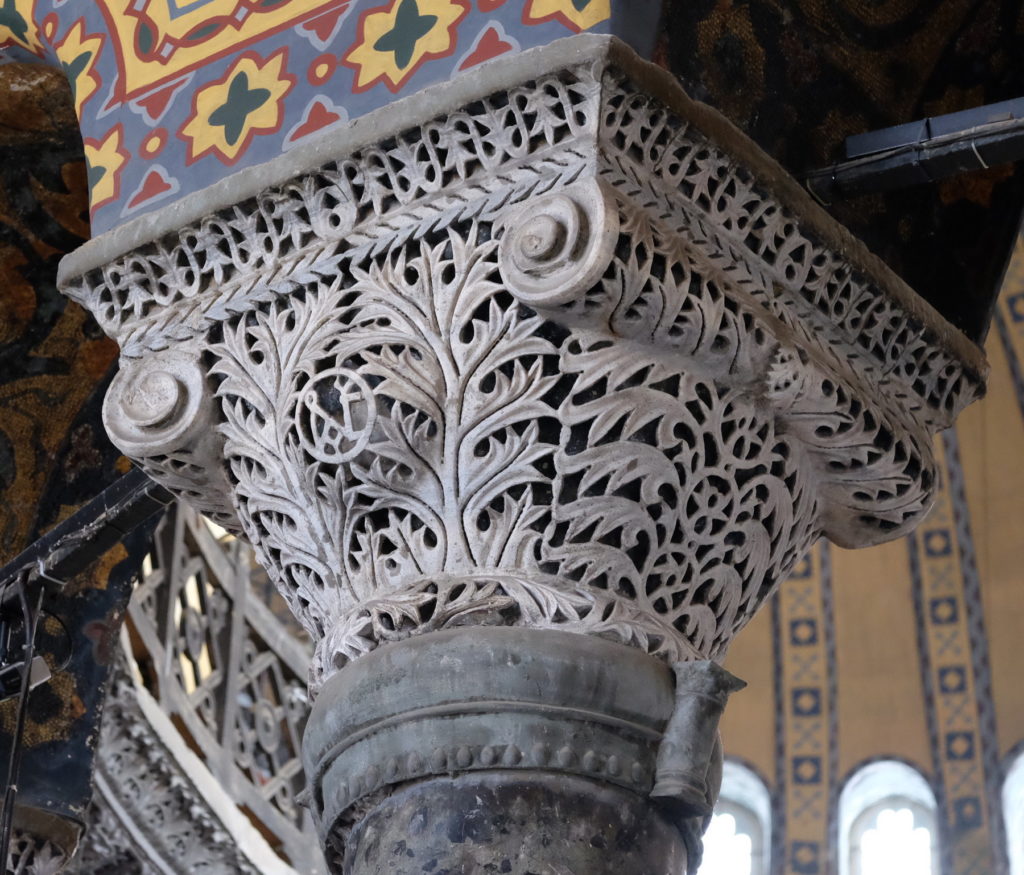
Capital with Monogram of Justinian at Hagia Sophia, 532–37, marble. Image by Brad Hostetler.
Monograms first appeared in public monumental settings in Constantinople during the sixth century CE.[7] The late Roman imperial princess Anicia Juliana (461/3–527/9 CE) had a variety of personal monograms carved in the marble piers of the church she commissioned in Constantinople, Hagios Polyeuktos; just a decade later, monograms naming the Eastern Roman Emperor and Empress Justinian I and Theodora (reigned 527–565 CE) were likewise carved into the architecture of the monumental cathedral Hagia Sophia, specifically the basket capitals atop its columns (fig. 3).[8] Paul the Silentiary (died 575–580 CE) in his dedicatory ekphrasis of the cathedral describes one such monogram: “the carver’s tool has incised one symbol that means many words, for it combines the names of the Empress and Emperor.”[9]
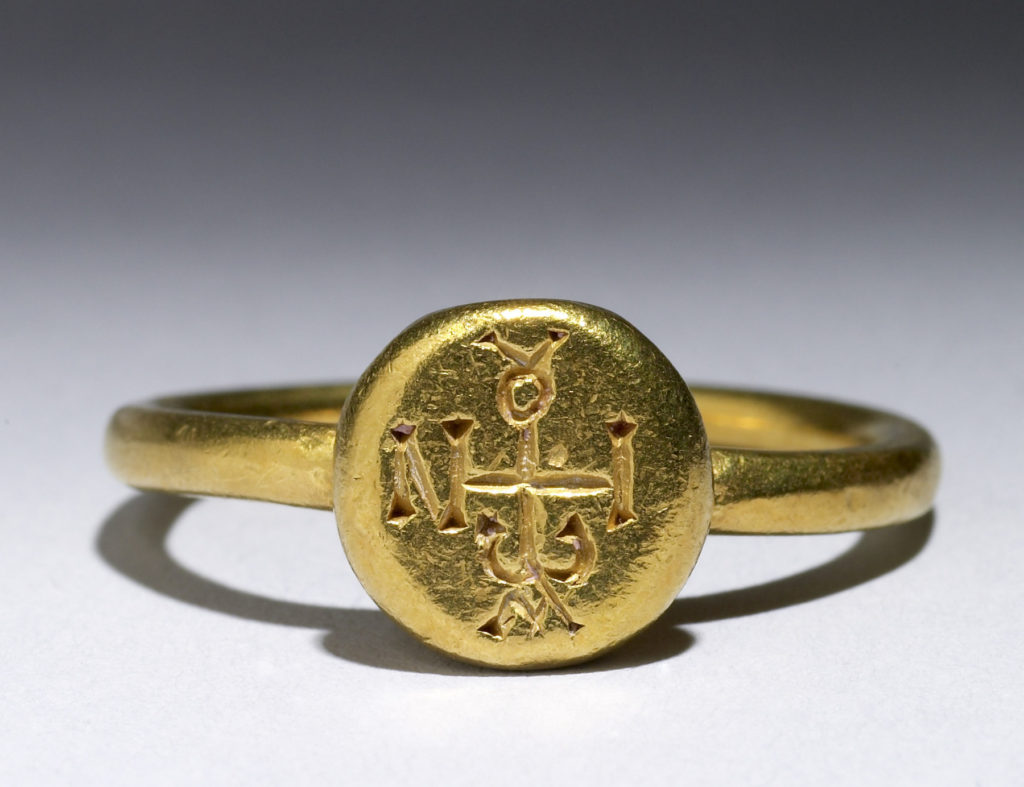
Signet Ring with “of John” in Greek, Byzantine, 6th–7th century, gold. The Walters Art Museum, Baltimore, Lent by the Zucker Family Trust, acc. no. TL.1985.10.59
Monograms of this late antique period are of two types. The first, used primarily between the fifth and seventh centuries, is known as the block monogram.[10] This type is based on a central block-shaped Latin or Greek letter, such as H, M, N, or Π, with other letters written around and attached to it. The monogram of Symmachus is an example of this type, in Latin, for which the M forms the central block. By the middle of the sixth century, designers gave preference to a different type, known as the cruciform monogram.[11] This type is composed predominantly of Greek letters that form part of, and are attached to, the arms of a cross. An example of a cruciform monogram that reads ΙΩΑΝΝΟΥ (“of John”) is incised on the bezel of the gold signet ring of the Zucker Family Collection, on loan to the Walters (fig. 4).[12]
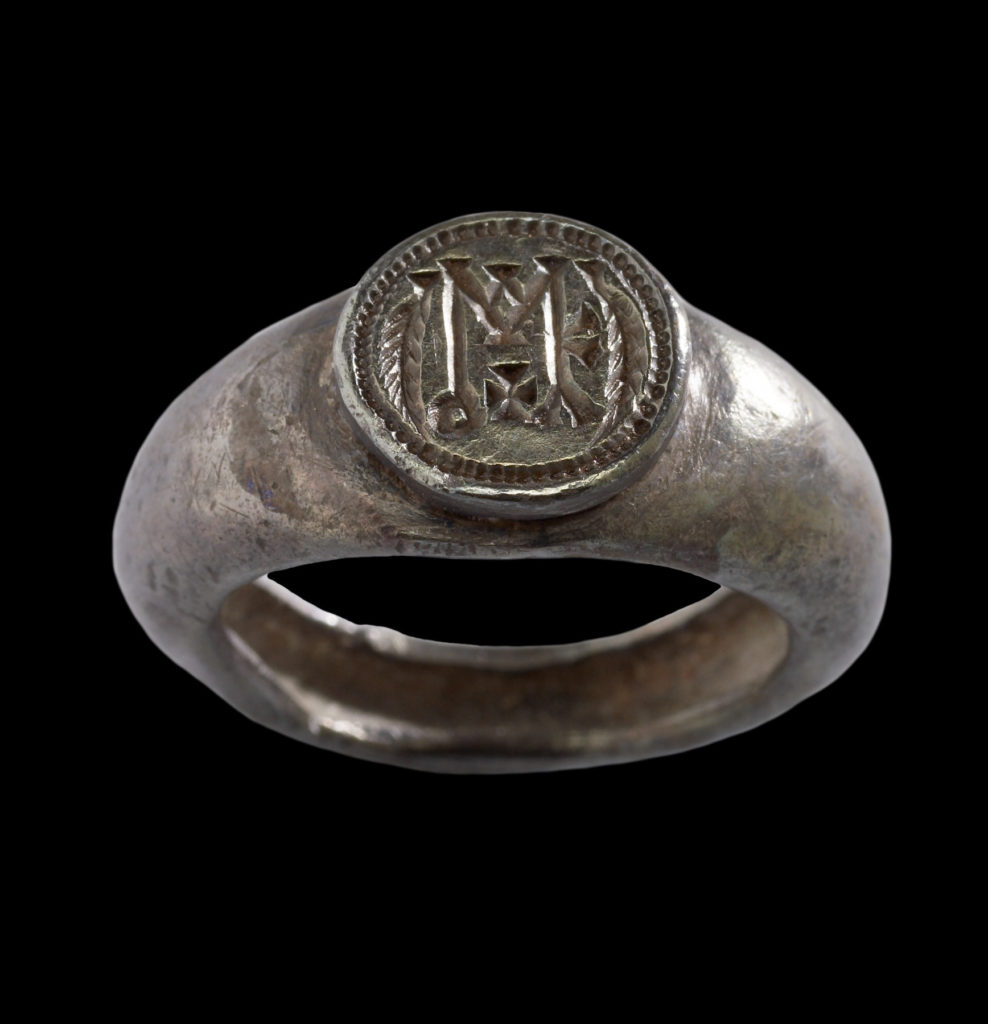
An older photograph of the Signet Ring with “of Akakios” in Greek, that orients the bezel at a 180-degree rotation, Byzantine, 6th–7th century. The Walters Art Museum, Baltimore, Museum purchase, 1986, acc. no. 57.2104
Returning to the silver signet ring, we can recognize that the monogram is of the block type. The 1985 sale catalogue at Günter Puhze identified the central block letter as M.[13] The gallery’s identification most likely influenced the Walters’ initial reading of the monogram as MAPKOY (“of Mark”), an interpretation that is problematic. According to this reading, the A and Y would be upside down vis-à-vis the central M; the K, when impressed, would read backwards; and the P is nowhere to be found (fig. 5). It is not unprecedented for a block monogram to feature backwards or upside-down letters, but in such cases, it was done to accommodate more letters within the design.[14] To correct this reading, we must rotate the bezel 180 degrees. In this orientation, the central block is formed by an A at the base and two vertical lines surmounted by the letters Y and O. The only asymmetrical letter, K, noticeably in reverse, extends from the left vertical line. Having correctly oriented the ring (fig. 1), the palm fronds are properly upright with the stems positioned at the lower end of the design and the leaves curving upward. The cross is also more appropriately positioned at the upper half of the design, rather than below the monogram. The drawing below presents the impression the signet would leave on items it sealed (fig. 6).
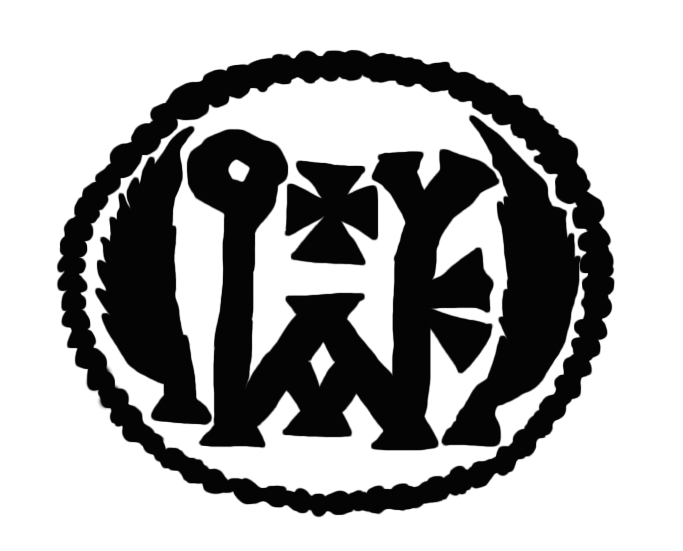
Impression of the Signet Ring of Akakios (drawing). Image by Brad Hostetler.
A similar block monogram is found on ten glass weights, dated to the sixth century.[15] One of these weights, at the British Museum, is made of blue glass and features a circular impression that consists of the monogram in the lower half of the medallion and an unidentified figural bust between two crosses in the upper half (fig. 7).[16] This monogram is formed by the Greek letters Α, Ι, Κ, Ο, and Υ, which Walter Fink and Chris Entwistle have read as the name ΑΚΑΚΙΟΥ (“of Akakios”).[17] Therefore, the same reading can be offered for the monogram on the Walters silver signet ring; however, there is no evidence that the same Akakios can be linked to the ring and any of the glass weights.
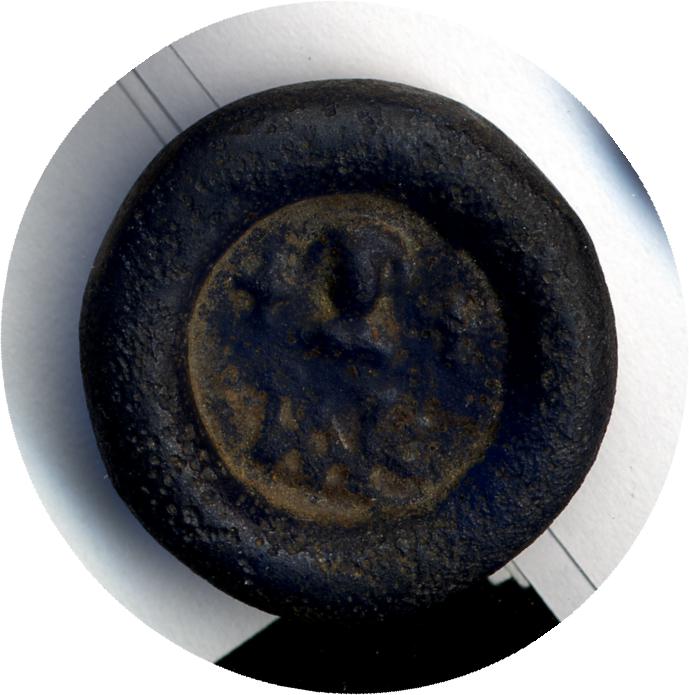
Weight of Akakios, Early Byzantine, 6th century, glass. The British Museum, 1997,0218.3. © The Trustees of the British Museum
How is it possible that the monogram on the Walters silver signet ring was misidentified? Monograms are difficult to read because there can be many solutions to any single design.[18] The Walters silver signet ring presents two particular challenges. One, reading this, or any, monogram is aided by the study of other monograms, regardless of where they occur or how they function: while the Akakios monogram has not yet been found on another signet ring, it is present on each of the ten glass weights mentioned previously. Two, the monogram is in reverse. If one looks at a monogram while holding a signet ring but is not expecting the monogram to be displayed in reverse, the impulse can be to rotate the bezel 180 degrees so that letters in reverse appear correctly oriented; a backward K, for example, would then appear properly oriented to the eye, but would lead to a misidentification of the other letters in the monogram.
These two challenges are reflected in publication and exhibition. The incorrect reading and inverted image of the bezel in The Medieval World, mentioned previously, likely determined the ring’s orientation in the Early Byzantine gallery at the Walters, where, at the time of writing this essay, it was displayed next to the gold signet ring of John—both with their bezels rotated 180 degrees.[19] This inaccurate orientation is by no means unique to the Walters. A gold signet ring at the British Museum, dated to the sixth century, features a block monogram, which I suggest may read ΕΛΙΣΣΑΙΟΥ (“of Elissaios”) (fig. 8).[20] When the ring was first published by Ormonde Maddock Dalton in 1901, an accompanying illustration of the monogram was properly oriented.[21] However, the photograph of the ring posted on the museum’s website presents the bezel rotated 180 degrees; the presence of the metric scale within the image makes it clear that the ring was photographed in the incorrect orientation.[22] The 2006 catalogue, The Road to Byzantium: Luxury Arts of Antiquity, published in conjunction with a joint exhibition between the State Hermitage Museum in Saint Petersburg and the Courtauld Institute of Art in London includes descriptions and photographs of three seventh-century gold rings from the Pereshchepina Treasure—a group of over 800 early medieval artifacts discovered in Ukraine in 1912—that may name the khans of Great Bulgaria, Organa and Kuvrat.[23] All three rings are inscribed with monograms, two of which are in reverse, indicating that these two rings functioned as signets.[24] In the accompanying photographs, the two signet rings are shown with their bezels rotated 180 degrees, while the other ring—whose monogram is not in reverse—is properly oriented. The Hermitage repeats this error on their website.[25]
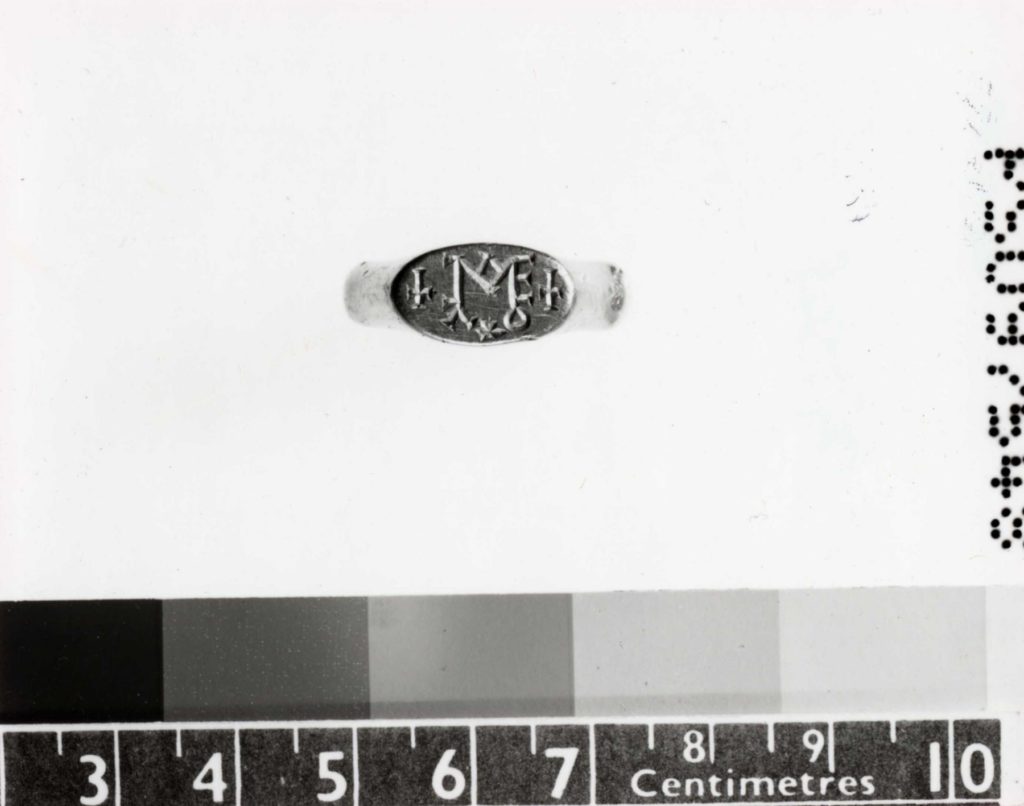
Photograph of the Signet Ring of Elissaios (?), that orients the bezel at a 180-degree rotation, Early Byzantine, 6th century, gold. The British Museum, AF.267. © The Trustees of the British Museum
Signet rings inscribed with longer Christian invocations on their bezels—features of Byzantine signet rings from the eighth century and later—have also been exhibited with their bezels rotated 180 degrees. An example is the sole signet ring included in the 2016 catalogue Sceaux de la collection George Zacos au Musée d’art et d’histoire de Genève.[26] The reverse inscription is displayed in five lines and provides the name of the wearer, his imperial title of spatharios (sword-bearer), his office of strategos (general), and his jurisdiction at the southern coast of Asia Minor: “Lord help Theophilos, the imperial spatharios and strategos of Kibyrrhaiotai.”[27] The catalogue entry is illustrated with two photographs, one of which focuses on the bezel inscription rotated 180 degrees (fig. 9). This error is notable considering that the volume catalogues 460 inscribed objects. However, the signet ring of Theophilos is fundamentally different from the lead seals that are the primary subject of the book. Whereas the ring was used to make impressions and is thus inscribed with a reverse inscription, the lead seals are impressions and thus feature inscriptions and monograms displayed in proper reading orientation.

Signet Ring of Theophilos with its bezel rotated 180 degrees, as illustrated in Maria Campagnolo-Pothitou and Jean-Claude Cheynet, Sceaux de la collection George Zacos au Musée d’art et d’histoire de Genève (Milan: 5 Continents, 2016), 153, no. 131
These examples in publications, museum galleries, and websites reveal the challenges inherent to studying monograms and inscriptions on signet rings. These objects have been examined primarily by scholars of sigillography (the study of seals), who are trained to study the impressions of inscriptions, and by art historians of jewelry, for which the inscriptions tend to be of secondary concern to materials and techniques. Signet rings present unique challenges that are related to, but distinct from, lead seals and other forms of jewelry. They require an integrated methodology informed by many disciplines, and demand their own approaches of viewing, analysis, and display.
I am grateful to Christine Sciacca for her guidance on the Medieval collection at the Walters, to the editors for their suggestions, and to Ruth Bowler and the rest of the publication staff for acquiring image rights. Funding from Kenyon College enabled me to pursue research at the Walters on another topic, which serendipitously led me to the silver signet ring. Graham Coursey, one of Kenyon’s first-rate librarians, helped me track down necessary sources to complete this project. My thanks to Chris Entwistle, who generously shared a draft of his research on the Byzantine weights at the British Museum, and to Lynn Jones for helping me work through numerous revisions of this note.
[1] Gary Vikan and John Nesbitt, Security in Byzantium: Locking, Sealing, and Weighing (Washington, DC: Dumbarton Oaks Center for Byzantine Studies, 1980), 16–20; Jeffrey Spier, Late Antique and Early Christian Gems (Wiesbaden: Reichert, 2007).
[2] Walters Art Museum, 57.2104, accessed July 25, 2021, https://art.thewalters.org/detail/40080/signet-ring-2/ .
[3] Martina Bagnoli and Kathryn Gerry, The Medieval World: The Walters Art Museum (Baltimore: Walters Art Museum, 2011), 196, fig. 113. The ring is illustrated in Sarah E. Bond, “Monograms and Inscribed Power,” History From Below (blog), June 17, 2014, https://sarahemilybond.com/2014/06/17/monograms-and-inscribed-power/; and Ildar Garipzanov, Graphic Signs of Authority in Late Antiquity and the Early Middle Ages, 300–900 (Oxford: Oxford University Press, 2018), 148, fig. 5.9b.
[4] Garipzanov, Graphic Signs, chap. 5.
[5] Translation in Garipzanov, Graphic Signs, 1. “Quo nomen meum magis intellegi quam legi promptum est.” XII, “Symmachi Epistulae,” in Quintus Aurelius Symmachus, Q. Aurelii Symmachi Quae Supersunt, ed. Otto Seeck (Berlin, 1883), 2:46.
[6] Edmund Weigand, “Ein bisher verkanntes Diptychon Symmachorum,” Jahrbuch des Deutschen Archäologischen Instituts 52 (1937): 121–38.
[7] Garipzanov, Graphic Signs, chap. 5.
[8] For an overview of the monograms in these monuments, see Jonathan Bardill, Brickstamps of Constantinople (Oxford: Oxford University Press, 2004), 1:48–49.
[9] Translation in Cyril Mango, The Art of the Byzantine Empire, 312–1453 (Englewood Cliffs, NJ: Prentice-Hall, 1972), 87.
“γράμμα χαράσσει / ἡ γλυφὶς ἓν πολύμυθον· ἀολλίζει γὰρ ἀνάσσης / οὔνομα καὶ βασιλῆος.” Paulus Silentiarius, Descriptio Sanctae Sophiae, ed. Claudio de Stefani (Berlin: De Gruyter, 2011), 49.
[10] Robert Feind, Byzantinische Monogramme und Eigennamen: Alphabetisiertes Wörterbuch = Byzantine Monograms and Personal Names: An Alphabetized Lexicon (Regenstauf: Edition Münzen und Sammeln, 2010), 35.
[11] Feind, Byzantinische Monogramme, 35.
[12] Walters Art Museum, TL.1985.10.59. Gary Vikan, “Early Christian and Byzantine Rings in the Zucker Family Collection,” The Journal of the Walters Art Gallery 45 (1987): 39, fig. 13.
[13] Galerie Günter Puhze, Katalog 6 (1985): 11, no. 102.
[14] See, for example, the monogram on the sixth-century silver spoon (British Museum, AF.379) that may be read ΑΝΔΡΕΟΥ ΕΠΙCΚΟΠΟΥ (“Bishop Andrew”); Walter Otto Fink, “Das byzantinische Monogramm,” (PhD diss, University of Vienna, 1971), 133, no. 25. Due to the monogram combining both a proper name and title, some letters are turned on their side and are backwards. For a drawing of the monogram, see O. M. Dalton, Catalogue of Early Christian Antiquities (London: British Museum, 1901), 84, no. 390.
[15] Chris Entwistle, A Catalogue of the Late Roman and Byzantine Weights and Weighing Equipment in the British Museum (forthcoming), nos. 699–701. In addition to these three glass weights at the British Museum, Entwistle cites seven other glass weights in various collections that bear the same monogram. I thank Dr. Entwistle for generously sharing with me a draft of his manuscript.
[16] The British Museum, 1997,0218.3; Entwistle, Catalogue, no. 700.
[17] Fink, “Das byzantinische Monogramm,” 130, no. 7; and Entwistle, Catalogue, no. 699.
[18] Werner Seibt, “The Use of Monograms on Byzantine Seals in the Early Middle-Ages (6th to 9th Centuries),” Parekbolai 6 (2016): 1–14, esp. 11–12.
[19] At the time of writing this essay, the ring was displayed on the Walters’ website with its bezel rotated 180 degrees. Garipzanov, Graphic Signs, 148, fig. 5.9b, illustrates the ring at its proper orientation, but the author does not comment on why it differs from the Walters’ orientation.
[20] British Museum, AF.267, accessed July 25, 2021, https://www.britishmuseum.org/collection/object/H_AF-267.
[21] Dalton, Early Christian Antiquities, 27, no. 168; Dalton, Catalogue of the Finger Rings, Early Christian, Byzantine, Teutonic, Mediaeval and Later (London: British Museum, 1912), 15, no. 88.
[22]Another signet ring (AF.268), dated to the sixth century, is also illustrated upside down on the British Museum’s website, https://www.britishmuseum.org/collection/object/H_AF-268 (accessed July 25, 2021).
[23] Frank Althaus and Mark Sutcliffe, eds., The Road to Byzantium: Luxury Arts of Antiquity (London: Courtauld Institute of Art, 2006), 167, nos. 107–109.
[24] The two signet rings are nos. 107 and 109.
[25] The State Hermitage Museum, W-1053, https://www.hermitagemuseum.org/wps/portal/hermitage/digital-collection/25.%20archaeological%20artifacts/483254/, and 1930-187, https://www.hermitagemuseum.org/wps/portal/hermitage/digital-collection/25.%20archaeological%20artifacts/1129168/ (accessed July 25, 2021).
[26] Musée d’Art et d’Histoire, Geneva, CdN 2004-538; Maria Campagnolo-Pothitou and Jean-Claude Cheynet, Sceaux de la collection George Zacos au Musée d’art et d’histoire de Genève (Milan: 5 Continents, 2016), 153, no. 131.
[27] Κ(ύρι)ε βοήθει Θεοφίλῳ β(ασιλικῷ) σπ(αθαρίῳ) κ(αὶ) στρ(ατηγῷ) τῶν Κυβεριωτῶ(ν). For a description of these titles, see Alexander Kazhdan, ed., The Oxford Dictionary of Byzantium, 3 vols. (Oxford: Oxford University Press, 1991), 2:1127, 3:1935–36, 3:1964.
